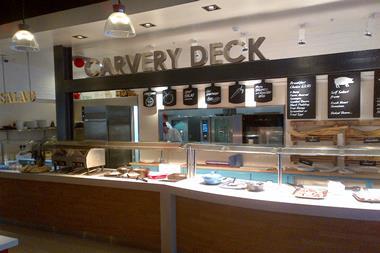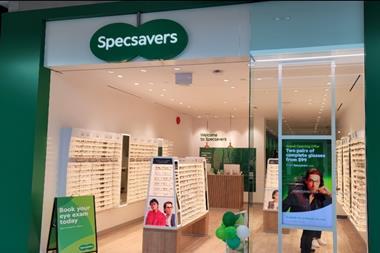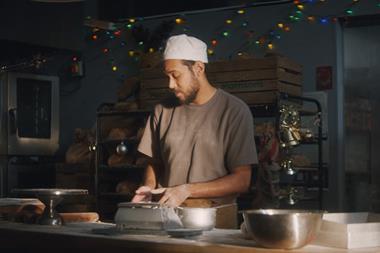Tesco has unveiled its vision of the future for big-box retail at its remodelled Tesco Extra in Watford, billed as a “brand new shopping and leisure destination”.

Subscribe to Retail Week
Want to read more on stores?
Subscribe for less than £1 a day and get immediate online access.
The shop, which reopened this week but is officially unveiled on August 12, is the first iteration of Tesco group chief executive Philip Clarke’s strategy to transform its giant stores and forms part of his £1bn investment in turning around the UK business.
After calling an end to the space race last year and focusing the business for the new digital era, Clarke embarked on plans to blur the traditional boundaries between shopping and leisure activities such as eating out.
Tony Hoggett, managing director of Tesco Extras, said: “We opened our first hypermarket nearly 20 years ago and sold everything under one roof but many things have changed since then. Online is growing exponentially and we knew it was time to change.”
Hoggett said customers told Tesco they did not enjoy the experience of shopping in its big stores and that the shops were not tailored to the local community or convenient.
“The strategy we devised from research was threefold,” said Hoggett. “We needed to make these stores exciting, relevant and convenient.”
The Watford format is exciting, Hoggett said, because it is a destination not just a store. “You can come to shop but you can also grab a coffee, or lunch, or use the community centre for classes,” he said.
Watford is relevant, Hoggett maintained, because it is tailored to the local community. “In the past all Extras were the same but now we will tailor them and get the right balance between GM and food for that catchment.”
Hoggett explained Tesco has made Watford convenient by putting food first. “Our shoppers wanted to be able to come in for a small shop, just grab some food for the evening, as well as do a big shop and the previous store didn’t cater to that.”
Tesco has moved fresh produce to the front of the branch for convenience, and the store also offers a full multichannel experience if that’s the way customers want to shop. “We’ve effectively built a supermarket at the front of an Extra store,” he said.
The Watford store is the first to house a Giraffe restaurant following Tesco’s acquisition of the business in March. Giraffe sits alongside the Tesco-backed Harris + Hoole coffee shop and its Euphorium bakery, as well as a new-look F&F clothing shop-in-shop.
The store also features a City Kitchen deli and revamped areas including fresh food, which houses a ‘misty veg’ table – an idea which Hoggett said Tesco brought over from Asia. The beers, wines and spirits section features innovations such as a cocktail display with recipes and tips given via a digital screen.
In an exclusive column for Retail Week last month, Clarke said the Watford revamp represents “the changing face of shopping”. He said the grocer’s use of space reflects the “profound changes we are seeing in retailing”.
The 80,000 sq ft shop, which originally opened in 1988, has been repurposed with the food first proposition, but also with attention to the non-food areas which Tesco believes shoppers still want to shop physically for. The split between food and non-food is still “roughly 50:50” said Hoggett, but “how we have used that space has vastly changed”.
“Non-food categories are moving online at different rates,” said Hoggett. “There are still a vast number of products that have a strong relationship with food shopping, and which customers tell us they still want to touch and feel before they buy.”
He said clothing and cookware are two categories Tesco is investing and which it believes will always have a place in a physical store. By contrast, the electricals range is around half the size it was prior to the remodeling.
The shop also includes ‘endless aisles’, in categories such as toys, so that customers can order from the full online range and have items delivered to the store’s click-and-collect desk, or to their homes.
The environment has also changed to include more low level tables and different lighting and flooring. Hoggett said: “Customers told us that they didn’t want to be rushed through aisles when they were buying products they needed to take some time choosing or wanted advice, such as beauty or wine, so we’ve made those areas warmer and easier to take your time in.”
Clarke said in his Retail Week column that Tesco has invested in businesses such as Giraffe to “build up a menu of options we can put into our stores”.
He said: “Watford shows one combination and in other stores that combination will be different, each tailored to provide the right offer for the local community.”
At Watford the community space is free to use and Hoggett said Tesco works with the groups in order to provide discounted classes. “Many of the classes held in the space will be free but those that have to charge, we want to make sure are offered to customers at a fraction of what they would cost normally,” he said. “The point of offering free space to groups is so we can give customers who may not usually be able to afford expensive courses the chance to take part at a discounted rate.”
Hoggett emphasised that while many of the elements in Watford will be rolled out, not all Extras will look the same. “Watford is a trial and we now have a menu of elements to roll out but we will only put them into stores where they are relevant for the customer,” he said.
Next week Tesco will reopen its Extra shops in Coventry Arena and Purley, and each has been remodeled differently. Coventry does not have a Giraffe but rather a new-look Tesco eatery called Decks, while Purley has “increased its food footprint dramatically”.
Hoggett said: “Watford is an urban destination, Coventry is on a retail park and Purley is a traditional food Extra so those three totally different stores will give us some real learnings about what works for bigger shops.”
He said there is nothing at Watford which Tesco does not believe to scalable. “There are no one-off gimmicks,” he said.
And while many critics of larger shops have called time on the hypermarket as a retail format, Hoggett said: “Reports of its death are greatly exaggerated”.
Tesco clearly sees Watford as the future of its hypermarkets, and shoppers will no doubt vote with their feet.


























1 Reader's comment